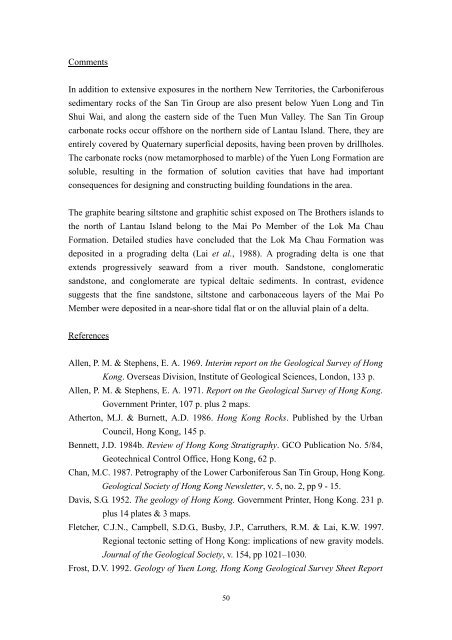Hong Kong Geology Guide Book Geotechnical Engineering Office ...
Hong Kong Geology Guide Book Geotechnical Engineering Office ...
Hong Kong Geology Guide Book Geotechnical Engineering Office ...
You also want an ePaper? Increase the reach of your titles
YUMPU automatically turns print PDFs into web optimized ePapers that Google loves.
Comments<br />
In addition to extensive exposures in the northern New Territories, the Carboniferous<br />
sedimentary rocks of the San Tin Group are also present below Yuen Long and Tin<br />
Shui Wai, and along the eastern side of the Tuen Mun Valley. The San Tin Group<br />
carbonate rocks occur offshore on the northern side of Lantau Island. There, they are<br />
entirely covered by Quaternary superficial deposits, having been proven by drillholes.<br />
The carbonate rocks (now metamorphosed to marble) of the Yuen Long Formation are<br />
soluble, resulting in the formation of solution cavities that have had important<br />
consequences for designing and constructing building foundations in the area.<br />
The graphite bearing siltstone and graphitic schist exposed on The Brothers islands to<br />
the north of Lantau Island belong to the Mai Po Member of the Lok Ma Chau<br />
Formation. Detailed studies have concluded that the Lok Ma Chau Formation was<br />
deposited in a prograding delta (Lai et al., 1988). A prograding delta is one that<br />
extends progressively seaward from a river mouth. Sandstone, conglomeratic<br />
sandstone, and conglomerate are typical deltaic sediments. In contrast, evidence<br />
suggests that the fine sandstone, siltstone and carbonaceous layers of the Mai Po<br />
Member were deposited in a near-shore tidal flat or on the alluvial plain of a delta.<br />
References<br />
Allen, P. M. & Stephens, E. A. 1969. Interim report on the Geological Survey of <strong>Hong</strong><br />
<strong>Kong</strong>. Overseas Division, Institute of Geological Sciences, London, 133 p.<br />
Allen, P. M. & Stephens, E. A. 1971. Report on the Geological Survey of <strong>Hong</strong> <strong>Kong</strong>.<br />
Government Printer, 107 p. plus 2 maps.<br />
Atherton, M.J. & Burnett, A.D. 1986. <strong>Hong</strong> <strong>Kong</strong> Rocks. Published by the Urban<br />
Council, <strong>Hong</strong> <strong>Kong</strong>, 145 p.<br />
Bennett, J.D. 1984b. Review of <strong>Hong</strong> <strong>Kong</strong> Stratigraphy. GCO Publication No. 5/84,<br />
<strong>Geotechnical</strong> Control <strong>Office</strong>, <strong>Hong</strong> <strong>Kong</strong>, 62 p.<br />
Chan, M.C. 1987. Petrography of the Lower Carboniferous San Tin Group, <strong>Hong</strong> <strong>Kong</strong>.<br />
Geological Society of <strong>Hong</strong> <strong>Kong</strong> Newsletter, v. 5, no. 2, pp 9 - 15.<br />
Davis, S.G. 1952. The geology of <strong>Hong</strong> <strong>Kong</strong>. Government Printer, <strong>Hong</strong> <strong>Kong</strong>. 231 p.<br />
plus 14 plates & 3 maps.<br />
Fletcher, C.J.N., Campbell, S.D.G., Busby, J.P., Carruthers, R.M. & Lai, K.W. 1997.<br />
Regional tectonic setting of <strong>Hong</strong> <strong>Kong</strong>: implications of new gravity models.<br />
Journal of the Geological Society, v. 154, pp 1021–1030.<br />
Frost, D.V. 1992. <strong>Geology</strong> of Yuen Long, <strong>Hong</strong> <strong>Kong</strong> Geological Survey Sheet Report<br />
50

















